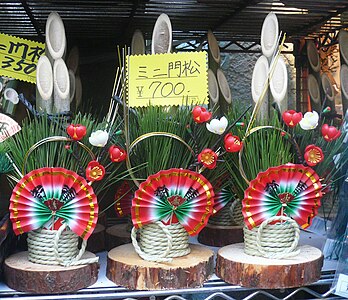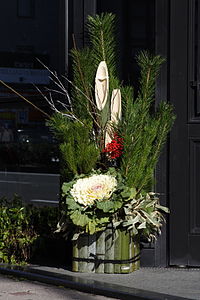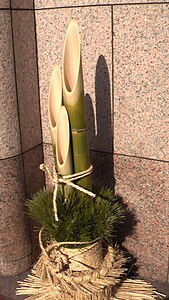Kadomatsu: Difference between revisions
mNo edit summary |
|||
| (5 intermediate revisions by 5 users not shown) | |||
| Line 3: | Line 3: | ||
{{Italic title|reason=[[:Category:Japanese words and phrases]]}} |
{{Italic title|reason=[[:Category:Japanese words and phrases]]}} |
||
[[File:SANY0032_(3158073374).jpg|thumb|right|Two ''kadomatsu'' made of bamboo]] |
[[File:SANY0032_(3158073374).jpg|thumb|right|Two ''kadomatsu'' made of bamboo]] |
||
[[File:Kadomatsu - nagano - 2023 Dec 30.ogg|thumb|thumbtime=1|Two kadomatsu at a Shinto shrine in [[Nagano Prefecture|Nagano]], 2023]] |
|||
{{Nihongo|'''''Kadomatsu'''''|[[Wiktionary:門松|門松]]||"gate [[pine]]"}} are traditional [[Japan]]ese decorations made for the [[Japanese New Year|New Year |
{{Nihongo|'''''Kadomatsu'''''|[[Wiktionary:門松|門松]]||"gate [[pine]]"}} are traditional [[Japan]]ese decorations made for the [[Japanese New Year|New Year]]. They are a type of ''[[yorishiro]]'', or objects intended to welcome ancestral spirits or ''[[kami]]'' of the harvest.<ref>{{Cite web|url=http://www.ikenobo.jp/english/about/history.html#his01|title=History of Ikebana | IKENOBO ORIGIN OF IKEBANA}}</ref> ''Kadomatsu'' are usually placed in pairs in front of homes and buildings. |
||
==Construction and placement== |
==Construction and placement== |
||
| Line 12: | Line 13: | ||
In modern times, ''kadomatsu'' are placed after [[Christmas]] until January 7 (or January 15 during the [[Edo period]]) and are considered temporary housing (''[[shintai]]'') for ''[[kami]]''. Designs for ''kadomatsu'' vary depending on region but are typically made of [[pine]], [[bamboo]], and sometimes [[ume]] tree sprigs which represent longevity, prosperity and steadfastness, respectively.<ref>{{Cite web|url=http://www.japantimes.co.jp/culture/2014/01/01/general/lucky-food-charming-decorations-visiting-deities-welcoming-the-new-year-with-history-tradition/#.VzkU7oR97IV|title=Lucky food, charming decorations, visiting deities: welcoming the new year with history, tradition {{!}} The Japan Times|website=The Japan Times|date=January 2014|language=en-US|access-date=2016-05-16}}</ref> "The fundamental function of the New Year ceremonies is to honor and receive the ''[[toshigami]]'' (deity), who will then bring a bountiful harvest for farmers and bestow the ancestors' blessing on everyone." After January 15 (or in many instances the 19th) the ''kadomatsu'' is burned to appease the ''kami'' or ''toshigami'' and release them. |
In modern times, ''kadomatsu'' are placed after [[Christmas]] until January 7 (or January 15 during the [[Edo period]]) and are considered temporary housing (''[[shintai]]'') for ''[[kami]]''. Designs for ''kadomatsu'' vary depending on region but are typically made of [[pine]], [[bamboo]], and sometimes [[ume]] tree sprigs which represent longevity, prosperity and steadfastness, respectively.<ref>{{Cite web|url=http://www.japantimes.co.jp/culture/2014/01/01/general/lucky-food-charming-decorations-visiting-deities-welcoming-the-new-year-with-history-tradition/#.VzkU7oR97IV|title=Lucky food, charming decorations, visiting deities: welcoming the new year with history, tradition {{!}} The Japan Times|website=The Japan Times|date=January 2014|language=en-US|access-date=2016-05-16}}</ref> "The fundamental function of the New Year ceremonies is to honor and receive the ''[[toshigami]]'' (deity), who will then bring a bountiful harvest for farmers and bestow the ancestors' blessing on everyone." After January 15 (or in many instances the 19th) the ''kadomatsu'' is burned to appease the ''kami'' or ''toshigami'' and release them. |
||
== Other |
== Other information == |
||
The ''kadomatsu'' is included in [[Unicode]] as {{unichar|1F38D|PINE DECORATION}}.<ref>{{cite web |url=http://emojipedia.org/pine-decoration/ |title=Pine Decoration Emoji |website=[[Emojipedia]]}}</ref> |
The ''kadomatsu'' is included in [[Unicode]] as the [[emoji]] {{unichar|1F38D|PINE DECORATION}}.<ref>{{cite web |title=Picture This: A List of Japanese Emoji |url=https://www.nippon.com/en/japan-topics/b00137/picture-this-a-list-of-japanese-emoji.html |website=Nippon.com|publisher=Nippon Communications Foundation |first=Richard |last=Medhurst |date=29 April 2019}}</ref><ref>{{cite web |url=http://emojipedia.org/pine-decoration/ |title=Pine Decoration Emoji |website=[[Emojipedia]]}}</ref> |
||
==Gallery== |
==Gallery== |
||
| Line 39: | Line 40: | ||
==References== |
==References== |
||
{{Reflist}}2. [http://thehawaiiherald.com/2012/12/all-about-kadomatsu/ The Hawaii Herald] |
{{Reflist}}2. [http://thehawaiiherald.com/2012/12/all-about-kadomatsu/ The Hawaii Herald] |
||
== External links == |
|||
{{Commonscat-inline|Kadomatsu}} |
|||
{{Shinto shrine}} |
{{Shinto shrine}} |
||
Latest revision as of 00:10, 19 February 2024

Kadomatsu (門松, "gate pine") are traditional Japanese decorations made for the New Year. They are a type of yorishiro, or objects intended to welcome ancestral spirits or kami of the harvest.[1] Kadomatsu are usually placed in pairs in front of homes and buildings.
Construction and placement
[edit]Historically, kadomatsu was often made with pine wood, but these days bamboo is more common. The central portion of the kadomatsu is formed from three large bamboos, though plastic kadomatsu are available. After binding all the elements of the kadomatsu, it is bound with a straw mat and newly woven straw rope. Kadomatsu are placed in pairs on either side of the gate, representing male and female.
Usage
[edit]In modern times, kadomatsu are placed after Christmas until January 7 (or January 15 during the Edo period) and are considered temporary housing (shintai) for kami. Designs for kadomatsu vary depending on region but are typically made of pine, bamboo, and sometimes ume tree sprigs which represent longevity, prosperity and steadfastness, respectively.[2] "The fundamental function of the New Year ceremonies is to honor and receive the toshigami (deity), who will then bring a bountiful harvest for farmers and bestow the ancestors' blessing on everyone." After January 15 (or in many instances the 19th) the kadomatsu is burned to appease the kami or toshigami and release them.
Other information
[edit]The kadomatsu is included in Unicode as the emoji U+1F38D 🎍 PINE DECORATION.[3][4]
Gallery
[edit]-
Kadomatsu of East Japan (Kantō region)
-
Kadomatsu of West Japan (Kansai region)
-
A small kadomatsu
-
Three miniature kadomatsu being sold outside for 700 Yen each
-
Kadomatsu
-
A small kadomatsu in a store
-
A kadomatsu in Kyoto style
-
Kadomatsu in the style of the Edo period
-
A flat topped kadomatsu in Shimane
-
Kadomatsu in Kamakura
See also
[edit]- Christmas tree
- Christmas wreath
- Corn dolly
- Mistletoe
- New Year tree
- Three Friends of Winter
- Trees in mythology
References
[edit]- ^ "History of Ikebana | IKENOBO ORIGIN OF IKEBANA".
- ^ "Lucky food, charming decorations, visiting deities: welcoming the new year with history, tradition | The Japan Times". The Japan Times. January 2014. Retrieved 2016-05-16.
- ^ Medhurst, Richard (29 April 2019). "Picture This: A List of Japanese Emoji". Nippon.com. Nippon Communications Foundation.
- ^ "Pine Decoration Emoji". Emojipedia.
External links
[edit]![]() Media related to Kadomatsu at Wikimedia Commons
Media related to Kadomatsu at Wikimedia Commons










